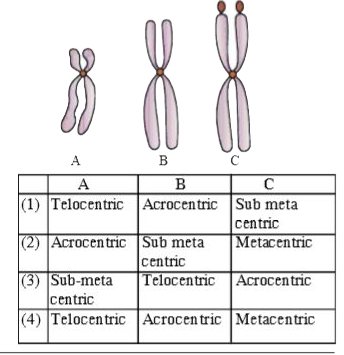What is a centromere? How does the position of centromere form the basis of classification of chromosomes. Support your answer with a diagram showing the position of centromere on different types of chromosomes.
Step-by-Step Text Solution:
Step 1: Definition of Centromere
A centromere is a specialized region of a chromosome that plays a crucial role during cell division. It is often referred to as the primary constriction of the chromosome. The centromere is a narrow, lightly stained area where two sister chromatids are joined together.
Step 2: Importance of Centromere Position
The position of the centromere on a chromosome is fundamental for the classification of chromosomes. Based on the location of the centromere, chromosomes can be categorized into four types: metacentric, submetacentric, acrocentric, and telocentric.
Step 3: Types of Chromosomes Based on Centromere Position
1. Metacentric Chromosomes: In metacentric chromosomes, the centromere is located at the center, resulting in two equal-length arms.
2. Submetacentric Chromosomes: In submetacentric chromosomes, the centromere is slightly off-center, leading to one arm that is shorter than the other.
3. Acrocentric Chromosomes: In acrocentric chromosomes, the centromere is located close to one end, creating one very short arm and one very long arm.
4. Telocentric Chromosomes: In telocentric chromosomes, the centromere is situated at the very end, resulting in one long arm and a very short arm that may be negligible.
Step 4: Diagram Representation
To illustrate the different types of chromosomes based on centromere position, a diagram can be drawn showing:
- Metacentric Chromosome: Two equal arms (A and B).
- Submetacentric Chromosome: One shorter arm (A) and one longer arm (B).
- Acrocentric Chromosome: One very short arm (A) and one very long arm (B).
- Telocentric Chromosome: One long arm (A) and a very short arm (B) that is barely visible.
A centromere is a specialized region of a chromosome that plays a crucial role during cell division. It is often referred to as the primary constriction of the chromosome. The centromere is a narrow, lightly stained area where two sister chromatids are joined together.
The position of the centromere on a chromosome is fundamental for the classification of chromosomes. Based on the location of the centromere, chromosomes can be categorized into four types: metacentric, submetacentric, acrocentric, and telocentric.
1. Metacentric Chromosomes: In metacentric chromosomes, the centromere is located at the center, resulting in two equal-length arms.
2. Submetacentric Chromosomes: In submetacentric chromosomes, the centromere is slightly off-center, leading to one arm that is shorter than the other.
3. Acrocentric Chromosomes: In acrocentric chromosomes, the centromere is located close to one end, creating one very short arm and one very long arm.
4. Telocentric Chromosomes: In telocentric chromosomes, the centromere is situated at the very end, resulting in one long arm and a very short arm that may be negligible.
To illustrate the different types of chromosomes based on centromere position, a diagram can be drawn showing:
- Metacentric Chromosome: Two equal arms (A and B).
- Submetacentric Chromosome: One shorter arm (A) and one longer arm (B).
- Acrocentric Chromosome: One very short arm (A) and one very long arm (B).
- Telocentric Chromosome: One long arm (A) and a very short arm (B) that is barely visible.
Topper's Solved these Questions
Similar Questions
What is a centromere ? How does the position of centromere form the basis of classification of chromosomes ? Support your answer with diagram showing the position of centromere on different types of chromosomes .
View SolutionExplain types of chromosomes on the basis of position of centromere.
View SolutionInto how many types the chromosomes can be classified based on the position of centromere?
View SolutionChromosomes at anaphase are of various shapes depending upon position of centromere. It is J shaped when centromere is
View SolutionChromosomes at anaphase are of various shapes depending upon position of centromere. It is J shaped when centromere is
View SolutionA karyotype is an arrangement of chromosomes from a cell based on their shape, size, and position of their centromeres.
View SolutionThe chromosomes can be divided based on the position of the centromere. A certain chromosomes appears 'L' shaped during the anaphase stage and has centromere slightly away from the middle of the chromosome. Such a chromosome will be
View SolutionA karyotype is used to study
I) Number of chromosomes
II) Position of centromere
III) Position of chromosome
IV) Length of the arms
V) Secondary constriction
View SolutionOne type of chromosome has middle centromere whereas the other has a terminal centromere. They are
View SolutionIdentify the type of chromosome with respect to centromere position :-

View Solution
